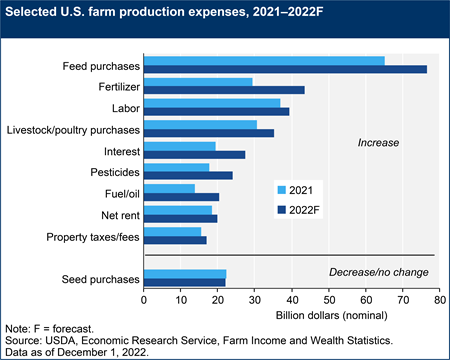
Features
Business/Policy
United States
USDA forecasts record farm sector profits for 2022
December 6, 2022 by USDA Economic Research Service
The USDA Economic Research Service has released its latest financial forecasts for the U.S. farm sector.
Net farm income, a broad measure of profits, is forecast to increase by $19.5 billion (13.8 percent) from 2021 to $160.5 billion in calendar year 2022. This expected increase follows an increase of $46.6 billion (49.3 percent) in 2021 from 2020. Net cash farm income is forecast to increase by $39.4 billion (26.5 percent) to $187.9 billion in 2022, after an increase of $31.7 billion (27.2 percent) in 2021. In inflation-adjusted dollars, 2022 net farm income is forecast to increase by $10.7 billion (7.2 percent); net cash farm income is forecast to increase by $30.1 billion (19.1 percent) compared with the previous year. If realized, net farm income would be at its highest level since 1973 and net cash farm income at its highest level on record (in inflation-adjusted dollars).
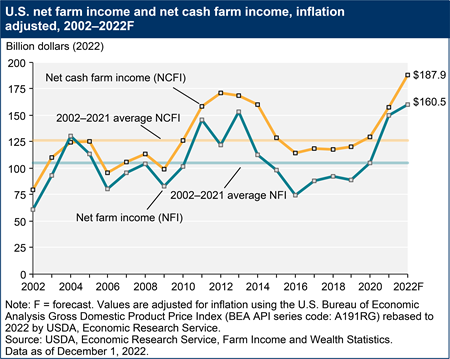
Note: In the text below, year-to-year changes in the major aggregate components of farm income are discussed only in nominal dollars unless the direction of the change is reversed when looking at the component in inflation-adjusted dollars.
Overall, farm cash receipts are forecast to increase by $105.7 billion (24.3 percent) to $541.5 billion in 2022 in nominal dollars. Total crop receipts are forecast to increase by $45.5 billion (19.0 percent) from 2021 levels to $285.5 billion. Receipts for corn are forecast to increase by $19.6 billion (27.6 percent), soybeans by $14.5 billion (29.5 percent), and wheat by $2.8 billion (23.7 percent) in 2022, accounting for much of the forecasted growth in crop cash receipts. Total animal/animal product receipts are expected to increase by $60.2 billion (30.8 percent) to $256.0 billion, following increases in receipts for all commodity categories (in nominal terms).
Direct Government farm payments are forecast at $16.5 billion in 2022, a $9.4 billion (36.3 percent) decrease from 2021 levels. Direct Government farm payments include Federal farm program payments paid directly to farmers and ranchers but exclude U.S. Department of Agriculture (USDA) loans and insurance indemnity payments made by the Federal Crop Insurance Corporation. Much of this decline is because of lower supplemental and ad hoc disaster assistance to farmers and ranchers related to the coronavirus (COVID-19) pandemic compared with 2021.
Total production expenses, including those associated with operator dwellings, are forecast to increase by $69.9 billion (18.8 percent) in 2022 to $442.0 billion. Nearly all categories of expenses are forecast to be higher in 2022 in nominal terms, with feed and fertilizer-lime-soil conditioner purchases expected to see the largest dollar increases.
Farm sector equity is expected to increase by 10.6 percent in 2022 to $3.34 trillion in nominal terms. Farm sector assets are forecast to increase 10.0 percent (nominal) in 2022 to $3.85 trillion following expected increases in the value of farm real estate assets. Farm sector debt is forecast to increase 5.9 percent in 2022 to $501.9 billion in nominal terms but fall by 0.4 percent when adjusted for inflation. Debt-to-asset levels for the sector are forecast to improve from 13.56 percent in 2021 to 13.05 percent in 2022. In 2022, working capital is forecast to rise 4.7 percent relative to 2021 in nominal dollars but fall by 1.4 percent when adjusted for inflation.
Animal/animal product receipts forecast to increase in 2022
Total animal/animal product cash receipts are expected to increase by $60.2 billion (30.8 percent in nominal terms) to $256.0 billion in calendar year 2022 relative to 2021. Growth in receipts is forecast for all major animal/animal products, with the largest percentage increases expected for chicken eggs, broilers, and milk.
Milk receipts are expected to increase by $15.9 billion (38.1 percent) in 2022, mainly due to higher forecasted prices. Cash receipts from cattle and calves are expected to increase by $13.9 billion (19.1 percent), also largely due to expectations for higher prices. Growth in prices is projected to outweigh lower quantities for hog receipts, resulting in an increase of $1.5 billion (5.5 percent) in 2022.
Broiler receipts are expected to increase by $17.4 billion (55.2 percent) in 2022, mostly due to a higher price forecast. Despite slightly lower quantities relative to 2021, expected higher prices should also drive receipts for turkeys $1.1 billion (19.0 percent) higher during the year. Cash receipts for chicken eggs are expected to more than double, with forecasted growth of $10.0 billion (115.0 percent), the result of expectations for much higher prices in 2022.
See data on value of animal/product production (in the value added table) and animal/product cash receipts.
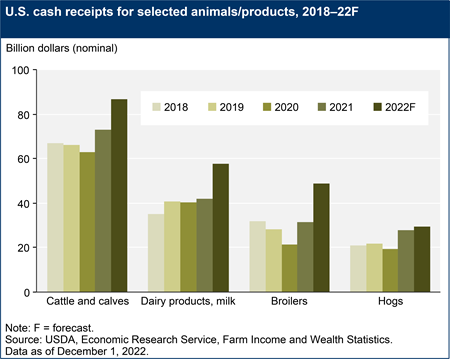
Direct government farm payments forecast to decrease in 2022
Direct Government farm program payments are those made by the Federal Government to farmers and ranchers with no intermediaries. Typically, most direct payments to farmers and ranchers are administered by the USDA under the Farm Bill or other authorities. Direct payments can also be from new supplemental programs authorized by Congress. Government payments do not include Federal Crop Insurance Corporation (FCIC) indemnity payments (listed as a separate component of farm income) and USDA loans (listed as a liability in the farm sector’s balance sheet). After reaching a record high of $45.6 billion in calendar year 2020, direct Government farm program payments are estimated to have decreased to $25.9 billion in 2021. They are forecast to decrease further to $16.5 billion in 2022. The overall decrease in 2021 and 2022 direct Government payments reflect lower anticipated payments from supplemental and ad hoc disaster assistance, including lower COVID-19 assistance.
- Supplemental and ad hoc disaster assistance payments in 2022 are forecast at $11.9 billion, a decrease of $7.1 billion, or 37.3 percent from 2021, primarily because of lower payments from COVID-19-related assistance programs.
-
- USDA pandemic assistance for producers, including the Coronavirus Food Assistance Program (CFAP), provides relief to producers whose operations are directly affected by the COVID-19 pandemic. Payments in calendar year 2022 from these USDA programs are forecast at $1.2 billion compared with $23.5 billion and $7.5 billion in 2020 and 2021, respectively.
- Non-USDA pandemic assistance—payments from the Paycheck Protection Program (PPP), administered by the Small Business Administration (SBA)—ended on May 31, 2021, and no payments are expected in 2022. Non-USDA pandemic assistance is estimated at $8.6 billion for 2021, based on October 2, 2022, data from the SBA. The PPP payments were designed to help small businesses keep their workers on the payroll through forgivable loans. Forgiven loan amounts are treated as a direct payment to farm operations.
- Other supplemental and ad hoc disaster assistance, which includes farm bill designated disaster programs, are forecast to be $10.7 billion in 2022, an increase of $7.8 billion from 2021, largely because of the recently passed Extending Government Funding and Delivering Emergency Assistance Act, which created the Emergency Relief Program (ERP) and the Emergency Livestock Relief Program (ELRP), and the assistance to distressed borrowers from the Inflation Reduction Act.
- Conservation payments from the financial assistance programs of USDA’s Farm Service Agency (FSA) and Natural Resources Conservation Service (NRCS) are expected to be $4.2 billion in 2022, up $635.4 million or 18.0 percent from 2021. The increase in conservation payments is due to a marginal increase in Conservation Reserve Program (CRP) enrolled acres and an increase in payments from NRCS programs.
- The Dairy Margin Coverage Program (DMC) is forecast to make $85.7 million in payments in 2022. Some payments were first triggered in August 2022, because of a drop in milk prices. Milk prices are forecast to fall further through the remainder of the 2022 calendar year.
- Farm bill commodity payments under the Agriculture Risk Coverage (ARC) and Price Loss Coverage (PLC) programs are forecast to decline by $1.9 billion, or 84 percent, in 2022 to $354 million. ARC payments are expected to be $105 million in 2022, a decrease of $12.5 million or 10.6 percent from 2021 levels. PLC payments in 2022 are expected be $248.6 million, a decrease of $1.9 billion, or 88.2 percent, from 2021 levels. ARC payments are expected to decrease in 2022 because of higher commodity prices for all covered commodities, especially corn and soybeans, in 2021 compared with 2020 levels. PLC payments are also expected to decrease in 2022 because of higher prices for all covered commodities in 2021 compared with 2020.
See data table on government payments.
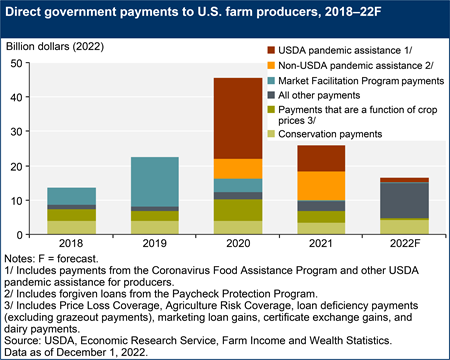
Production expenses forecast to increase in 2022
Farm sector production expenses—including expenses associated with operator dwellings—are forecast to increase by $69.9 billion (18.8 percent) to reach $442.0 billion in calendar year 2022. This would represent the largest year-to-year dollar increase in nominal terms on record. When adjusted for inflation, production expenses are forecast to increase by 11.8 percent from 2021 to 2022, yet remain below the record-high levels of 2012–14.
See data tables on production expenses.
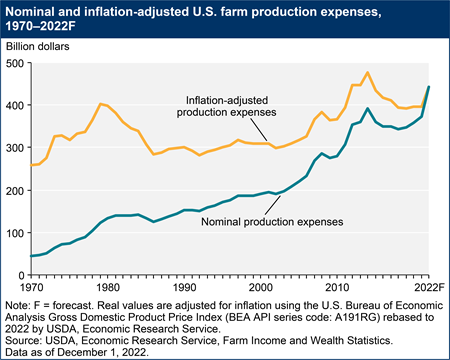
Nearly all expense categories are forecast to rise in 2022 compared with the previous year, with the most significant increases in nominal terms for the following categories:
- Fertilizer-lime-soil conditioner expenses are forecast to increase by $13.9 billion (47.0 percent) to $43.4 billion in 2022.
- Feed expenses, the largest single expense category, are forecast to increase in 2022 by $11.3 billion (17.4 percent), to $76.6 billion because of higher prices for feed commodities.
- Interest expenses (including operator dwellings) are also forecast to increase in 2022 by $8.0 billion (41.0 percent) to $27.4 billion.
- Fuel and oil expenses are forecast to increase by $6.6 billion, or 47.4 percent, to reach $20.5 billion in 2022, which is the highest percentage increase among the main expense categories.
